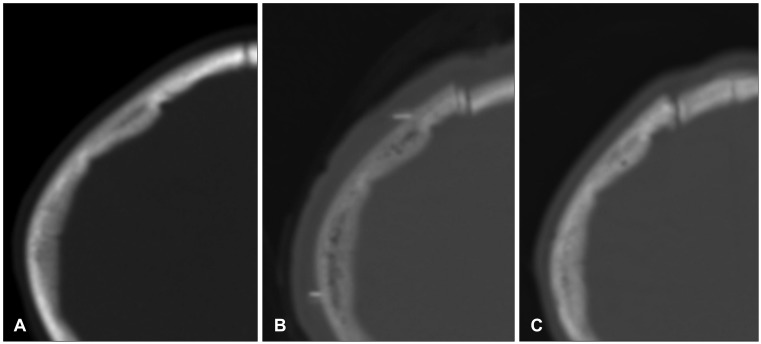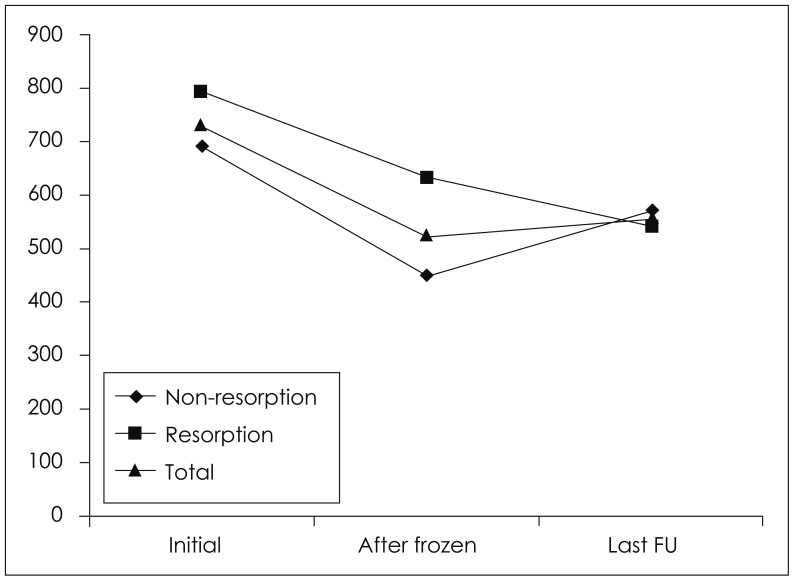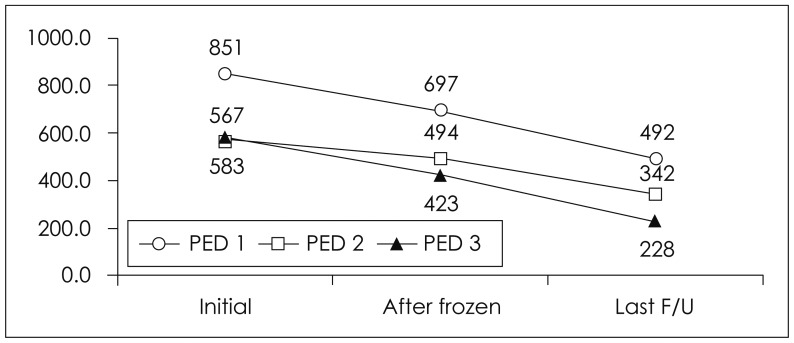Korean J Neurotrauma.
2014 Apr;10(1):10-14. 10.13004/kjnt.2014.10.1.10.
Resorption of Autogenous Bone Graft in Cranioplasty: Resorption and Reintegration Failure
- Affiliations
-
- 1Department of Neurosurgery, Gil Medical Center, Gachon University, Incheon, Korea. nschan@gilhospital.com
- KMID: 2156091
- DOI: http://doi.org/10.13004/kjnt.2014.10.1.10
Abstract
OBJECTIVE
Re-implantation of autologous skull bone has been known to be difficult because of its propensity for resorption. Moreover, the structural characteristics of the area of the defect cannot tolerate physiologic loading, which is an important factor for graft healing. This paper describes our experiences and results with cranioplasty following decompressive craniectomy using autologous bone flaps.
METHODS
In an institutional review, the authors identified 18 patients (11 male and 7 female) in whom autologous cranioplasty was performed after decompressive craniectomy from January 2008 to December 2011. We examined the age, reasons for craniectomy, size of the skull defect, presence of bony resorption, and postoperative complications.
RESULTS
Postoperative bone resorption occurred in eight cases (44.4%). Among them, two experienced symptomatic breakdown of the autologous bone graft that required a second operation to reconstruct the skull contour using porous polyethylene implant (Medpor(R)). The incidence of bone resorption was more common in the pediatric group and in those with large cranial defects (>120 cm2). No significant correlation was found with sex, reasons for craniectomy, and cryopreservation period.
CONCLUSION
The use of autologous bone flap for reconstruction of a skull defect after decompressive craniectomy is a quick and cost-effective method. But, the resorption rate was greater in children and in patients with large skull defects. As a result, we suggest compressive force of the tightened scalp, young age, large skull defect, the gap between bone flap and bone edge and heat sterilization of autologous bone as risk factors for bone resorption.
Keyword
MeSH Terms
Figure
Cited by 3 articles
-
Bone Flap Changes after Cranioplasty Using Frozen Autologous Bone Flaps: A Three-Dimensional Volumetric Reconstruction Study
Jung Hwan Lee, Chung Kee Chough, Hyuk Jin Choi, Jun Kyeung Ko, Won Ho Cho, Seung Heon Cha, Chang Hwa Choi, Young Ha Kim
Yonsei Med J. 2019;60(11):1067-1073. doi: 10.3349/ymj.2019.60.11.1067.Bone Flap Resorption Following Cranioplasty after Decompressive Craniectomy: Preliminary Report
Ji Sang Kim, Jin Hwan Cheong, Je Il Ryu, Jae Min Kim, Choong Hyun Kim
Korean J Neurotrauma. 2015;11(1):1-5. doi: 10.13004/kjnt.2015.11.1.1.Review of Cranioplasty after Decompressive Craniectomy
Yong Jun Cho, Suk Hyung Kang
Korean J Neurotrauma. 2017;13(1):9-14. doi: 10.13004/kjnt.2017.13.1.9.
Reference
-
1. Aarabi B, Hesdorffer DC, Ahn ES, Aresco C, Scalea TM, Eisenberg HM. Outcome following decompressive craniectomy for malignant swelling due to severe head injury. J Neurosurg. 2006; 104:469–479. PMID: 16619648.
Article2. Brooks RA. A quantitative theory of the Hounsfield unit and its application to dual energy scanning. J Comput Assist Tomogr. 1977; 1:487–493. PMID: 615229.
Article3. Bullock MR, Chesnut R, Ghajar J, Gordon D, Hartl R, Newell DW, et al. Surgical management of traumatic parenchymal lesions. Neurosurgery. 2006; 58(3 Suppl):S25–S46. discussion Si-Siv. PMID: 16540746.
Article4. Citardi MJ, Friedman CD. Nonvascularized autogenous bone grafts for craniofacial skeletal augmentation and replacement. Otolaryngol Clin North Am. 1994; 27:891–910. PMID: 7816437.
Article5. Dujovny M, Agner C, Aviles A. Syndrome of the trephined: theory and facts. Crit Rev Neurosurg. 1999; 9:271–278. PMID: 10525845.
Article6. Dujovny M, Aviles A, Agner C, Fernandez P, Charbel FT. Cranioplasty: cosmetic or therapeutic? Surg Neurol. 1997; 47:238–241. PMID: 9068693.
Article7. Durand JL, Renier D, Marchac D. [The history of cranioplasty]. Ann Chir Plast Esthet. 1997; 42:75–83. PMID: 9768140.8. Iwama T, Yamada J, Imai S, Shinoda J, Funakoshi T, Sakai N. The use of frozen autogenous bone flaps in delayed cranioplasty revisited. Neurosurgery. 2003; 52:591–596. discussion 595-596. PMID: 12590683.
Article9. Lee BS, Min KS, Lee MS, Kim YG, Kim DH. Comparison with subcutaneous abdominal preservation and cryoconservation using autologous bone flap after decompressive craniectomy. Korean J Neurotrauma. 2012; 8:21–25.
Article10. Oppenheimer AJ, Tong L, Buchman SR. Craniofacial Bone Grafting: Wolff's Law Revisited. Craniomaxillofac Trauma Reconstr. 2008; 1:49–61. PMID: 22110789.
Article11. Osawa M, Hara H, Ichinose Y, Koyama T, Kobayashi S, Sugita Y. Cranioplasty with a frozen and autoclaved bone flap. Acta Neurochir (Wien). 1990; 102:38–41. PMID: 2305650.
Article12. Park J, Ries J, Gelse K, Kloss F, von der Mark K, Wiltfang J, et al. Bone regeneration in critical size defects by cell-mediated BMP-2 gene transfer: a comparison of adenoviral vectors and liposomes. Gene Ther. 2003; 10:1089–1098. PMID: 12808439.
Article13. Prolo DJ, Oklund SA. Composite autogeneic human cranioplasty: frozen skull supplemented with fresh iliac corticocancellous bone. Neurosurgery. 1984; 15:846–851. PMID: 6514157.
Article14. Son S, Park CW, Kim EY, Kim JM, Yoo CJ. Bone resorption of autologous cranioplasty following decompressive craniectomy in children: case report. J Korean Neurotraumatol Soc. 2009; 5:118–123.15. Vanaclocha V, Sáiz-Sapena N, García-Casasola C, De Alava E. Cranioplasty with autogenous autoclaved calvarial bone flap in the cases of tumoural invasion. Acta Neurochir (Wien). 1997; 139:970–976. PMID: 9401658.
Article16. Ward GWR. The grove encyclopedia of materials and techniques in art. New York: Oxford University Press;2008. p. 699.
- Full Text Links
- Actions
-
Cited
- CITED
-
- Close
- Share
- Similar articles
-
- Ridge Augmentation Using Block Type of Autogenous Tooth Bone Graft Material in Severe Alveolar Bone Resorption of Single Tooth: Case Report
- Analysis of Cranioplasty Using Frozen Autologous Bone Following Post-Traumatic Decompressive Craniectomy
- The retrospective study of marginal bone loss around dental implants according to different autogenous bone grafts
- Delayed and recurrent surgical site infection from resorbed bone fragment after autologous cranioplasty: a case report
- Long-Term Incidence and Predicting Factors of Cranioplasty Infection after Decompressive Craniectomy




